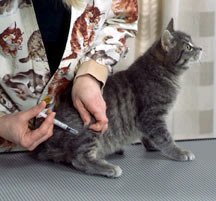A New Look at Vaccines
 Monday, December 20, 2010 at 01:00PM
Monday, December 20, 2010 at 01:00PM  By: Laura Stoeker
By: Laura Stoeker
North Carolina State University
Our companion animals are routinely vaccinated against infectious diseases that target the respiratory, intestinal, and reproductive tracts, collectively known as mucosal tissue. Veterinarians typically inject vaccines into the muscle, leading to a system-wide immune response. However, recent research suggests that vaccine effectiveness may be improved by administering a vaccine at the pathogen’s point of entry, leading to a stronger local immune response that may prevent initial entry of the pathogen into the host.
Lactobacillus, a probiotic bacteria, can be used to deliver proteins that will help the host develop a barrier against a particular pathogen before becoming infected. This bacteria-based approach has shown promise in the development of vaccines against tetanus, SARS, and human papilloma virus, amongst others. Though these studies traditionally involve live animal models, our proposition includes the development of a system to test the effectiveness of a Lactobacillus-based vaccine without animal usage, using feline immunodeficiency virus as a model. We anticipate that other researchers will ultimately be able to utilize this approach to vaccine design as well, decreasing the use of research animals in this area. In addition, by employing Lactobacillus in a vaccination strategy, we expect to improve the effectiveness of immunization against mucosal pathogens, leading to improvement in the quality of life of our companion animals.
 North Carolina,
North Carolina,  Small animal in
Small animal in  Cases/Abstracts
Cases/Abstracts 